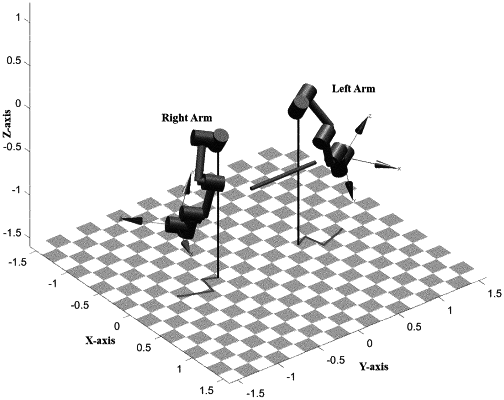| CPC B25J 9/1612 (2013.01) [B25J 9/023 (2013.01); B25J 9/1638 (2013.01); G06N 3/12 (2013.01)] | 15 Claims |

|
1. A method for selecting an optimal grasp posture of a dual-arm robot based on an improved genetic algorithm, comprising:
S1: determining a value range of a fitness function and an iteration quantity threshold with a goal of minimizing the posture variation at the end effectors of dual arms, designing the fitness function based on the position relationship between the dual arms and the to-be-grasped rod member and motion laws of the dual arms, then setting initial crossover and mutation ratios;
S2: taking initial postures of the dual arms and the position of the to-be-grasped rod member as constraints for generating an initial population representing the grasping position; the above specific content of taking the initial postures of the dual arms and the position of the target to-be-grasped rod member as constraints for generating an initial population are as follows: the target grasping points are generated on the axis of the target object to be grasped, and the initial population of each gene group contains two points representing the dual-arm target positions distributed on both sides of the object's centroid;
S3: calculating fitness of each group of genes in the population based on the fitness function designed in the S1;
S4: determining whether the fitness of each group of genes in the population in the S3 is within the set value range of the fitness function in the S1, and performing S9 if the fitness of each group of genes in the population in the S3 is within the set value range of the fitness function in the S1, otherwise, performing S5;
S5: determining whether a quantity of iterations reaches the iteration quantity threshold set in the S1, and performing S9 if the quantity of iterations reaches the iteration quantity threshold set in the S1, otherwise, performing S6;
S6: obtaining a new-generation population genes through crossover and mutation operations;
S7: for the population genes that are not subjected to the crossover and mutation operations in the S6, dynamically selecting a gene retention strategy to retain the genes based on the iteration depth of the population genes in the quantity of iterations, the fitness value, the grasping position, and postures at the end effectors of the dual arms;
S8: updating the population genes representing the grasping position based on the new-generation population genes in the S6 and the genes retained in the S7, then returning to perform the S3; and
S9: obtaining an optimal target corresponding to the dual arms.
|